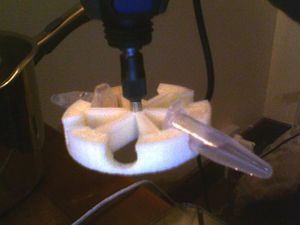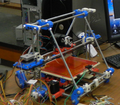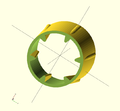
Full title: 3-D Printing of Open Source Appropriate Technologies for Self-Directed Sustainable Development
The technological evolution of the 3-D printer, widespread internet access and inexpensive computing has made a new means of open design capable of accelerating self-directed sustainable development. This study critically examines how open source 3-D printers, such as the RepRap and Fab@home, enable the use of designs in the public domain to fabricate open source appropriate technology (OSAT), which are easily and economically made from readily available resources by local communities to meet their needs. The current capabilities of open source 3-D printers is reviewed and a new classification scheme is proposed for OSATs that are technically feasible and economically viable for production. Then, a methodology for quantifying the properties of printed parts and a research trajectory is outlined to extend the existing technology to provide complete village-level fabrication of OSATs. Finally, conclusions are drawn on the potential for open source 3-D printers to assist in driving sustainable development.
Using open source 3-D printers to make AT[edit | edit source]
There have been a number of open source 3D printers, such as the Rep Rap developed. The basic idea for this project is to use them as tools to create OSAT in the field to help the goals of sustainable development. Prices on 3D printers are dropping rapidly[1]
An example of how these 3D printers can be used to meet these goals is the DremelFuge[2] (Fig.1), which is an open-source tool for scientists.[3] The Dremelfuge is brilliant Open Source Hardware project developed by Cathal Garvey in Ireland. The DremelFuge is a printable rotor for centrifuging standard microcentrifuge tubes and miniprep columns. It is at least 10 times less expensive than a standard centrifuge and can be used by field workers in doing things like blood tests, but also by DIY biologists and educators. It requires industry standard 1.5ml/2ml Eppendorf/Microcentrifuge tubes.
- Used with a drill at 3000 RPM, the Dremelfuge will deliver over 400g, enough to comfortably spin down Miniprep samples (proven personally). It will likely achieve acceptable results at lower speeds, too.
- Used at 10krpm, on a Rotary tool for instance, a Dremelfuge should deliver over 4400g, more than enough to spin down bacterial cells.
- At 16krpm, Dremelfuge matches commercial centrifuges.
- On a Dremel 300, a maximum speed of 33krpm equates to a force of over 50,000 times earth's gravity, which puts it into so-called "Ultracentrifuge" territory. The latest version (as printed by Shapeways) has successfully spun tubes at this speed.
Map of 3DP for Development[edit | edit source]
Tech for Trade has a nice map of the major groups working throughout the world with 3D printing for development - http://web.archive.org/web/20160913214444/http://techfortrade.org/our-initiatives/3d4d-challenge/
Calculating the Value of OSAT Development[edit | edit source]
Examples[edit | edit source]
For hundreds of more examples see:
For a relatively up to date list of examples see this collection of OSAT or this collection of open source scientific hardware. It is also possible to recycle e-waste into more RepRaps see [2].
- hand held corn sheller
- customized prosthetics
- solar water pasteurization manifolds, absorbers
- valves
- water wheels
Tools[edit | edit source]
- OSAT 3-D Printing Tools
Energy[edit | edit source]
- OSAT 3D-Printable Designs for Energy
Medicine[edit | edit source]
| Not Impossible Labs Using 3D Printers Prototypes for Prosthetic Hands |
|---|
- OSAT 3D-Printable Designs for Medicine
-
OphthalmicDocs Fundus - a 3D printed universal smartphone retinal imaging adapter.
Water[edit | edit source]
- OSAT 3-D Printable Designs for Water Use
Agriculture[edit | edit source]
- OSAT 3-D Printable Designs for Agricultural Use
3D Printable OSAT Designs[edit | edit source]
- OSAT 3D-Printable Designs
In the News[edit | edit source]
| Hands on Search - Yahoo Japan to help blind children |
|---|
- Enter A Competition To Show How 3D Printing Might Change The World - Tree Hugger Nov 7, 2011 and 3Ders.org
- 3D Sustainable Design Contest Opens to International Competition Kingston Herald
- Mit 3D-Druckern gegen Armut (With 3D printers against poverty)-- Heute.de (German) 3-27-2013
- Mit 3D-Druckern gegen Armut (With 3D printers against poverty)-- ZDF Hyperland (German), Giuseppe-Paletta (German)
- 3D printers may be poised to take off in developing countries - Engineering for Change
- Hand of a superhero NYT
- Doctor Brings Low-Cost Medical Supplies to Gaza with 3D Printing - 3D Printing Industry
- 3D4MD Puts a 3D Printer in the Doctor's Bag of the Future - 3D Printing Industry
Future work[edit | edit source]
When coupled with the open source appropriate technology (OSAT) community the user's own experience with designs, innovations, and inventions can be similarly made available for the public usually through an open internet protocol such as an appropriate technology wiki like Appropedia. These open source technological advances thus have the potential to spur a virtuous cycle founded on a traditional hacker gift culture. Those with the best designs, which are provided free for the world community, are rewarded with prestige and develop their reputations in the global innovation community in the same way academics carefully nurture their h-indexes. This project outlines a research trajectory to improve local feed stock availability, size, and material properties to extend the existing technology to provide a complete village-level fabrication independence. Finally open source 3-D printing will be evaluated as a disruptive technology to challenge the conventional closed, top-down, corporate and colonial forms of development with an open, peer to peer, local self-reliant federation for providing abundance from existing resources.
Links Associated with Project[edit | edit source]
- Building research equipment with free, open-source hardware
- Reprap wiki
- Rapman protocol
- RapMan
- Open source 3D printer literature review
- 3D Model to G-Code File for Rapman
- Reprap Build and Test at Queen's University
- Solar Powered RepRap for OSAT
- 3D printers for peace contest
- Smallholder women farmers in Africa aided by 3-D Printing by 3d4agdev.org
- Mechanical Properties of Components Fabricated with Open-Source 3-D Printers Under Realistic Environmental Conditions
- Distributed manufacturing with 3-D printing: a case study of recreational vehicle solar photovoltaic mounting systems
See also[edit | edit source]
- Open source 3D printers: an appropriate technology for building low cost optics labs for the developing communities
- re:3D
- Tech for Trade, Tech for Trade continues to bring emerging tech to the developing world
- Open Book on "Low-cost 3D Printing for Science, Education and Sustainable Development" - Free e-book and Free HD lecture series
- The Potential for W. Afate, the First 3D Printer Created from e-Waste - 3D Printing Industry
- 3D printed water distiller
- How a Medical Clinic in the Bolivian Rainforest Might Use 3D Printing
- Open Source 3D-Printable Planetary Roller Screw for Food Processing Applications
- RMRDtech - 3D printed windmills
- Applications of Open Source 3-D Printing on Small Farms
- OpenBionics (Lulzbot printed PLA+ninjaflex splints)
- esherpa
- 3D printing to redefine the medical supply chain in Africa - 3D Printing Industry
- Development of a Resilient 3-D Printer for Humanitarian Crisis Response
- Open-source 3-D Printing in Managing Humanitarian Innovation
- Chemical Compatibility of Fused Filament Fabrication-based 3-D Printed Components with Solutions Commonly Used in Semiconductor Wet Processing
- Mechanical properties of 3-D printed truss-like lattice biopolymer non-stochastic structures for sandwich panels with natural fibre composite skins
Supporting Material: Classification With Examples[edit | edit source]
| Technical Constraints on OSAT | Can be printed in currently
viable materials |
Cannot be printed with currently
viable materials |
| Fits on present printer bed | Complete items: valves for water systems (Madungwe & Sakuringwa, 2007); airtight plastic waterproof containers (Mtaita, 2003); joining andmounting components for sediment water filters (Hazeltine, 2003);plastic models of concepts for educational purposes (Lipson,2007); protective cases for AT items such as the BogoLight (Pilloton, 2009); ergonomic handles for objects (Ergon,2010);window frame components such as locks or sliding tracks(Hazeltine, 2003) (Mtaita 2003; Slesin & De Chabaneix, 1986);component pieces of frames with many uses – e.g. hospital equipment (England, 1979).
|
Complete items: mechanical componentsfor industrial use, bicycles, home or farming equipment ranging from tools (Branch, 1978; DeCristoforo, 1977; Hurt, 1985; Weygers, 1973) such as wrenches, hammers, and shovels,task-specific tools for production (Clegg, 1988),and general mechanical parts such as simple gears and bearings (SchoolsCouncil Project Technology, 1985).
|
| Does not fit on present printer bed | solar dehydrators (Dahlman & Forst, 2001; Forst, 2002; Valdez & Valdez, 1977); concrete molds, required for a variety of items such as rain water catchers (Pacey & Cullis, 1986);environmentally and socially sustainable household construction items (Abidin, 2010; Wekesa, Steyn, & Otieno, 2010); screened louvered shutters for windows (Slesin & De Chabaneix, 1986); windows and doors (Kahn, 1973); solar still platforms; wind pumps(Mann, 1979) large covers for electrical equipment (Phipps, 1983) | locking desalination pressure cooker (Buros, 2000); furnace and stove pieces (Forst, 2001; 2002); wind or water turbines (Durali, 1976); high-temperature solar cooker components (Sharma, Sethi, & Chopra, 1990; Hazeltine, 2003; Hazeltine & Bull, 2003; Sharma, 1990); housing projects; large farm and industrial equipment; children's playgrounds; bulky medical equipment;transportation containers |
Table of Supporting Material: Further OSAT ideas and their technical potential to be printed on open-source 3-D printers
Table References[edit | edit source]
Abidin, N. Z. (2010). Investigating the awareness and application of sustainable construction concept by Malaysian developers. Habitat International, 34(4), 421-426.
Bach, O., 'Hope,' 'M. J., Chaheka, C. V., & Dzimbiri,' K. M.(2004). Disability can be avoided after open fractures in Africa? Results from Malawi. Injury, 35(9), 846-851.
Batidzirai, B., Lysen, E. H., Van Egmond, S., & Van Sark, W. G. J. H. M. (2009). Potential for solar water heating in Zimbabwe. Renewable and Sustainable Energy Reviews, 13(3), 567-582.
Branch, D.S. (Ed.). (1978). Tools for homesteaders, gardeners, and small-scale farmers. Emmaus: Rodale Press Inc.
Brattle, L. V., & Irving, R. J. (1986). Appropriate household technology: charcoal stoves. Journal of Consumer Studies & Home Economics, 10(1), 35-43.
Buros, O.K. (2000). The ABCs of desalting (2nd ed.). Topsfield: International Desalination Association.
Consumers association testing and research laboratories (CATRL). (1984). Laboratory testing of handpumps for developing countries: Final technical report (UNDP Project Management Report No. 3). Rural Water Supply Handpumps Project. Washington D.C.: World Bank Publications.
Clegg, C. (1988). Appropriate technology for manufacturing: Some management issues. Applied Ergonomics, 19(1), 25-34.
Dahlman, J., & Forst, C. (2000). Briquette presses for alternate fuel use. Technologies demonstrated at ECHO. North Fort Myers: ECHO.
Dahlman, J., & Forst, C. (2001). The solar dehydrator. In Technologies demonstrated at ECHO. North Fort Myers: ECHO.
DeCristoforo, R. (1977). Handtool handbook for woodworking. Tucson: H.P. Books.
Denkenberger, D.C. & Pearce, J.M. (2006). Compound Parabolic Concentrators for Solar Water Heat Pasteurization: Numerical Simulation. Proceedings of the 2006 International Conference of Solar Cooking and Food Processing, 108.
Durali, M. (1976). Design of Small Water Turbines for Farms and Small Communities. Cambridge MA: Technology Adaptation Program, Massachusetts Institute of Technology.
England, R. (Ed.). (1979). How to make basic hospital equipment. London: Intermediate Technology Publications.
Ergon, (2010), Ergon Bike Ergonomics. [Online] Available: http://www.ergon-bike.com/us/en/home (July 5, 2010).
Forst, C. (2001). Floating drum biogas digester. In Technologies demonstrated at ECHO. North Fort Myers: ECHO.
Forst, C. (2002a). Drum type cookstove. In Technologies Demonstrated at ECHO. North Fort Myers: ECHO.
Forst, C. (2002b). Seed drying cabinet. In Technologies demonstrated at ECHO. North Fort Myers: ECHO.
Forst, C. (2003a). PVC Ball Check Hand Pumps. In Technologies Demonstrated at ECHO. North Fort Myers: ECHO. </font
Forst, C. (2003b). PVC Check Valve Hand Pumps. In Technologies Demonstrated at ECHO. North Fort Myers: ECHO.
Fraenkel, P. (1986). Water pumping devices: A handbook for users and choosers. London: Intermediate Technology Publications.
Hazeltine, B. (2003). Water Supply. In B. Hazeltine & C. Bull (Eds.). Field Guide to Appropriate Technology. San Diego: Elsevier Science, 731-738.
Hazeltine, B. & Bull, C. (Eds.) (2003). Field Guide to Appropriate Technology. San Diego: Elsevier Science.
Hurst, C. (1990). Establishing new markets for mature energy equipment in developing countries: Experience with windmills, hydro-powered mills and solar water heaters. World Development, 18(4), 605-615.
Hurt, R. D. (1985). American farm tools. Manhattan: Sunflower University Press.
International Rice Research Institute. (1985). Small farm equipment for developing countries. Paper presented at the International Conference on Small Farm Equipment for Developing Countries: Past Experiences and Future Priorities. Manila, Phillipines.
Inversin, A. R. (1977). The construction of a hydraulic ram pump. Boroko: South Pacific Appropriate Technology Foundation.
Kim, J., & Mulholland, S. (1999). Seating/wheelchair technology in the developing world: Need for a closer look. Technology and Disability, 11(1), 21-27.
Khanna, R.. K., Rathore, R.S., & Sharma, C. (2008). Solar still an appropriate technology for potable water need of remote villages of desert state of India — Rajasthan. Desalination, 220(1-3), 645-653.
Lipson H. (2007). Printable 3D Models for Customized Hands-on Education. Paper presented at Mass Customization and Personalization (MCPC) 2007, Cambridge, Massachusetts, United States of America.
Madungwe, E., & Sakuringwa, S. (2007). Greywater reuse: A strategy for water demand management in Harare? Physics and Chemistry of the Earth, Parts A/B/C, 32(15-18), 1231-1236.
Mann, R. (1979). How to build a cretan-sail wind pump for use in low speed wind conditions. London: Intermediate Technology Publications.
Mtaita, T. A. (2003). Food. In B. Hazeltine & C. Bull (Eds.), Field Guide to Appropriate Technology. San Diego: Elsevier Science, 277-282.
Pacey, A., & Cullis, A. (1986). Rainwater harvesting: the collection of rainfall and runoff in rural areas. London: Intermediate Technology Publications.
Pearce, J.M. & Denkenberger, D.C. (2006). Numerical Simulation of the Direct Application of Compound Parabolic Concentrators to a Single Effect Basin Solar Still. Proceedings of the 2006 International Conference of Solar Cooking and Food Processing, 118.
Pearlman, J., Cooper, R. A., Zipfel, E., Cooper, R., & McCartney, M. (2006). Towards the development of an effective technology transfer model of wheelchairs to developing countries. Disability & Rehabilitation: Assistive Technology, 1(1-2), 103-110.
Phipps, L. J. (1983). Mechanics in Agriculture. Danville IL: The Interstate Printers and Publishers, Inc, (Chapter 39).
Pilloton, E. (2009). Design revolution: 100 products that empower people. New York: D.A.P./Distributed Art Publishers.
Schools Council Project Technology. (1985). Industrial Archeology of Watermills and Waterpower. London: Heinemann Educational Books Ltd.
Sharma, S. K., Sethi, B. P. S., & Chopra, S. (1990). Thermal performance of the "Rohini"—An improved wood cookstove. Energy Conversion and Management, 30(4), 409-419.
Sharp, D., & Graham, M. (Eds.). (1982). Village handpump technology: research and evaluation in Asia. Ottawa: International Development Research Centre.
Slesin, S., & De Chabaneix, G. (1986). Caribbean style. London: Thames and Hudson.
Taiwo, K.A., Ogwu, E. N., & Ajibola, O.O. (2001). Technological considerations in the utilisation and maintenance of household kitchen equipment. Technovation, 21(11), 747-755.
Tschannerl, G., & Bryan, K. (1984). Handpumps testing and development: proceedings of a workshop in China (UNDP Project Management Report No. 5). Rural Water Supply Handpumps Project. Washington: Publications Office of World Bank.
Valdez, M., & Valdez, A. (1977). A cookbook for building a solar food dryer. Colorado: Arnold & Maria Valdez.
Wekesa, B. W., Steyn, G. S., & Otieno, F. A. O.. (2010). The response of common building construction technologies to the urban poor and their environment. Building and Environment, 45(10), 2327-2335.
Weygers, A. (1973). The making of tools. New York: Van Nostrand Reinhold Company, (Chapters 3-17).
Other Approaches[edit | edit source]
- Solar Sinter project - uses focused solar power to sinter sand in a 3D printer setup
- The Sun Cutter Project explores the potential of harnessing sunlight directly to produce objects. The machine is a low-tech, low energy version of a laser cutter. It uses pure sunlight, focused by a ball lens, to repeatedly cut programmed shapes in up to 0.4mm thick plywood as well as paper and card.
- 3D printing a house
- 3D printed wind turbines part 1: Design considerations and rapid manufacture potential- http://www.sciencedirect.com/science/article/pii/S221313881500003X
See also[edit | edit source]
- Requests for 3-D printable open source appropriate technology
- Applications of Open Source GMAW-Based Metal 3-D Printing
References[edit | edit source]
- ↑ http://www.3ders.org/3d-printer/3d-printer-price.html
- ↑ http://www.thingiverse.com/thing:1483
- ↑ Pearce, Joshua M. 2012. "Building Research Equipment with Free, Open-Source Hardware." Science 337 (6100): 1303–1304. Podcast
































































































































